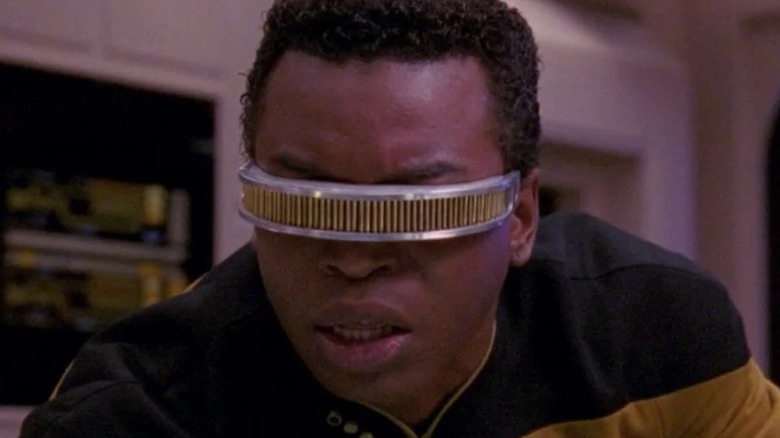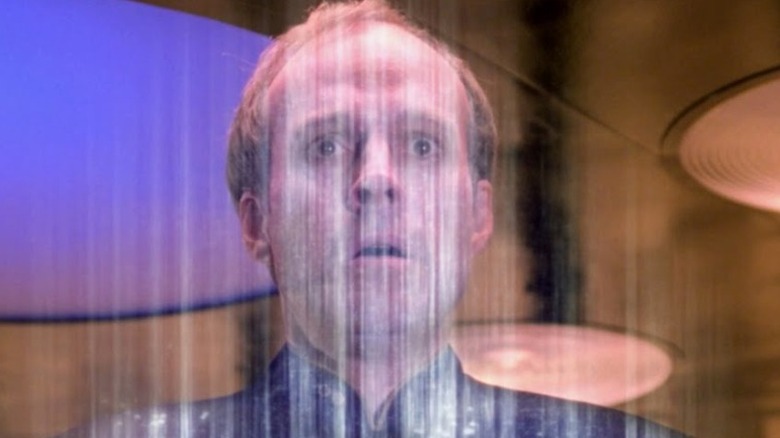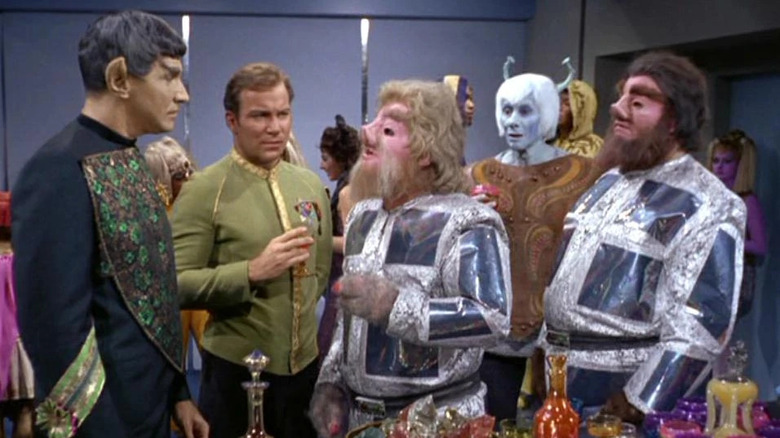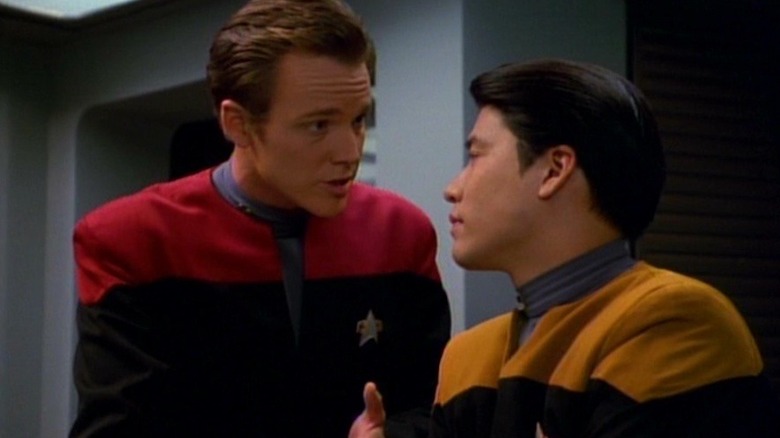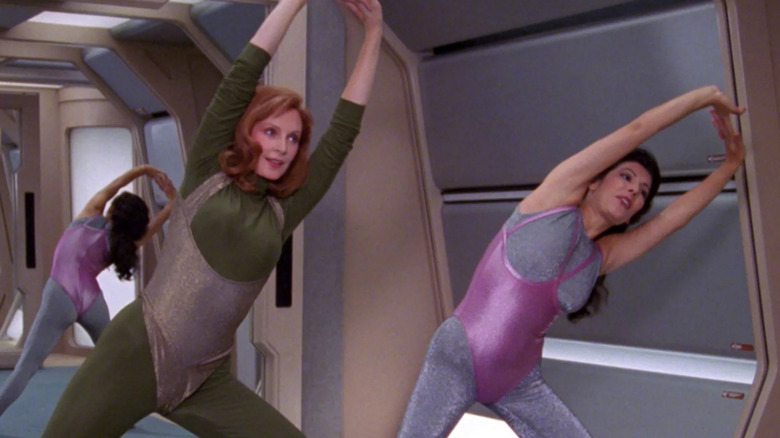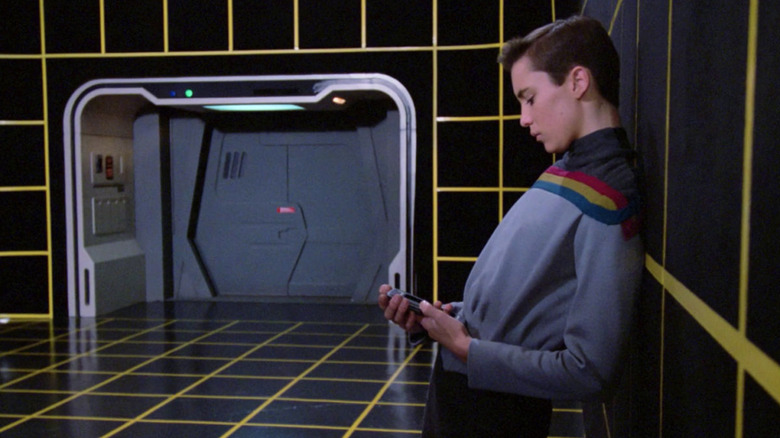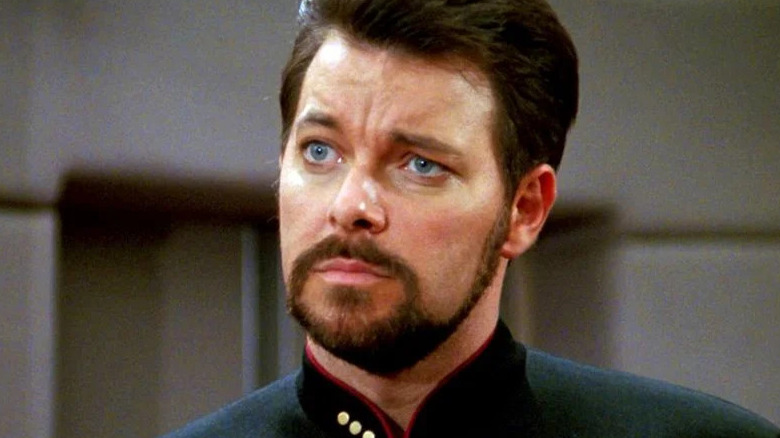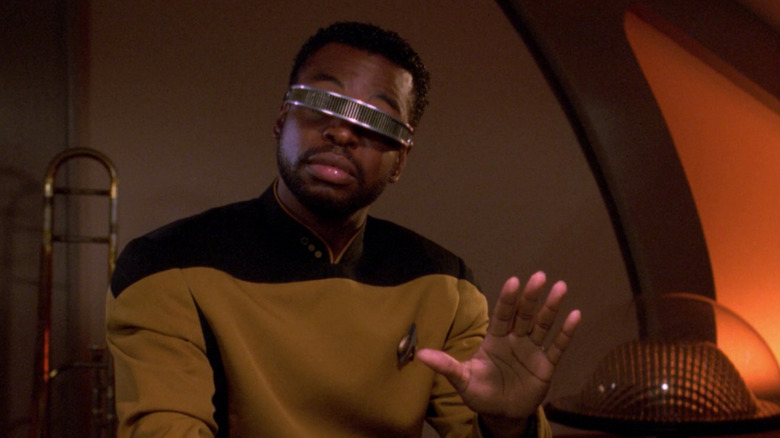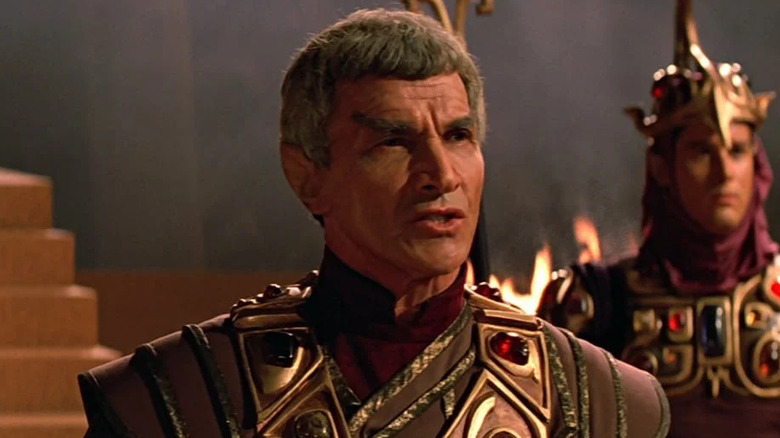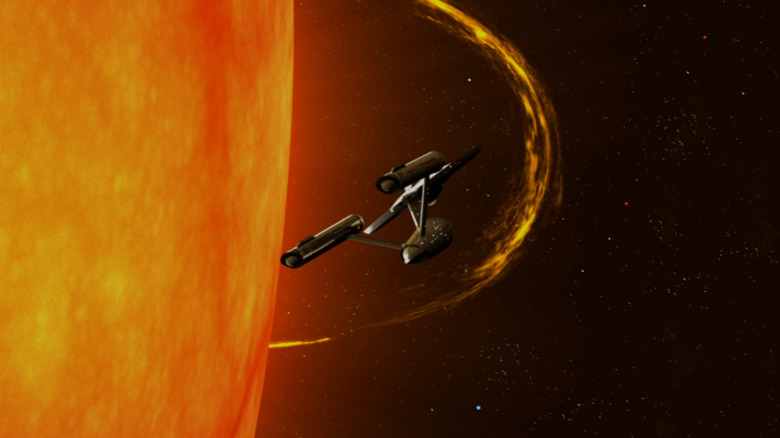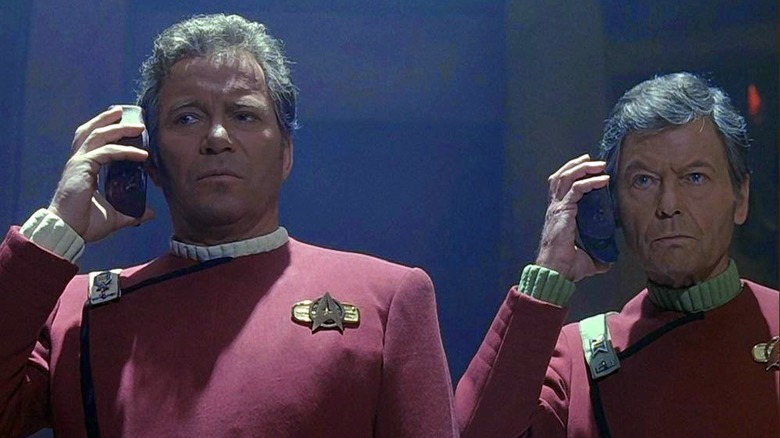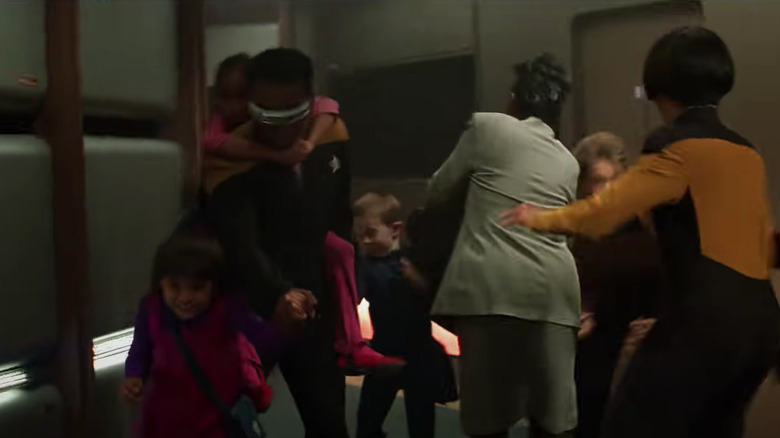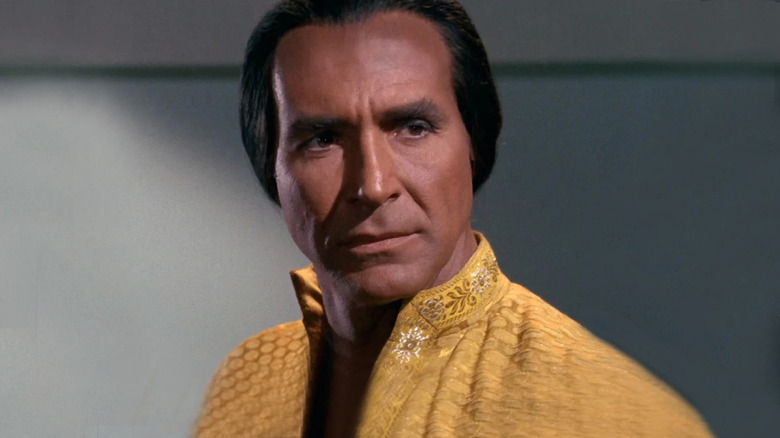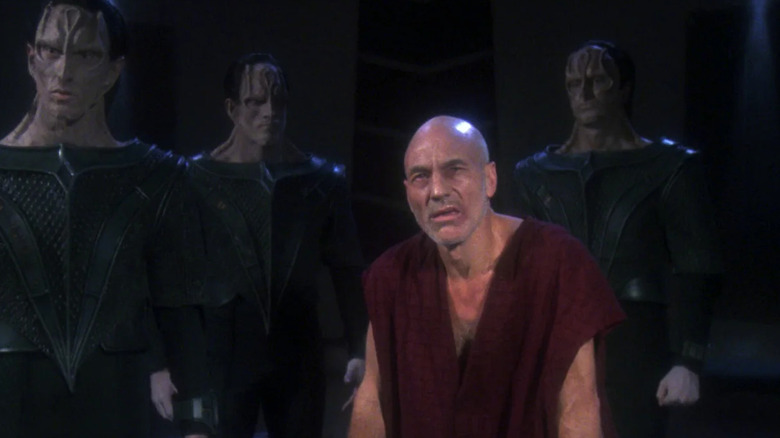Questionable Things We Ignore In The Star Trek Franchise
The "Star Trek" franchise has been running since 1966, and in that time it has become one of the most beloved, successful, and iconic science fiction series ever made. Through its many TV series and even more feature films, "Star Trek" has built a fully realized universe full of drama, conflict, and excitement. In a universe hundreds of years in our future, Earth has progressed to an age of enlightenment, made contact with alien civilizations, and built a United Federation of Planets that stretches across the galaxy.
The series has told all kinds of stories and popularized sci-fi concepts genre fans now often take for granted, like transporters, holodecks, and even warp speed. We take so much of "Star Trek" for granted, in fact, that there are some elements to the series that might deserve some closer scrutiny. Details that, upon further inspection, don't add up. Some of these components of the "Star Trek" franchise even become a little unsettling the more you think about them.
Some of these issues revolve around classic pieces of "Star Trek" technology that might be more than they first appear while others are related to the unusual ways the franchise has portrayed different aliens, cultures, and Starfleet itself. Here are the most questionable things in the "Star Trek" franchise that most audiences have been ignoring.
Transporters are killing machines
While it might be a bit of an exaggeration to call the most important device in "Star Trek" a killing machine, there's been endless debate among diehard Trekkies for decades on the topic. Does the transporter actually send you from one place to another, or does it just annihilate your body and make a copy on the other end?
We're content enough to trust the fictional scientists on this one and believe that it's the safest way to travel. However, it remains suspect that it's never questioned within the show, and most viewers take the device at face value a little too easily. Sure, there have been a few episodes that deal with transporter phobia (such as the "The Next Generation" episode "Realm Of Fear"), but those primarily focus on the fear of a malfunction and being killed in transport rather than the fundamental nature of the device itself.
Of course, this is one element of "Star Trek" that is almost necessary to overlook, as without it episodes would wind up spending far too much time explaining how characters get from place to place in outer space. It's a hand-waving conceit so they can move the stories forward — but it still seems questionable that nobody seems very concerned about the basic science behind these devices.
Aliens make no sense
From the earliest days of "Star Trek," nearly every race we've met has resembled ourselves. Vulcans, Klingons, Romulans, and even the Borg. They're all just like us — except for the make-up and prosthetics. Sure, some have forehead ridges, bumps, and scales, but only on rare occasions have we seen genuinely alien aliens. Some of the few exceptions to this relative uniformity include the Sheliak in "The Next Generation" episode "The Ensigns of Command" and Species 10-C in "Star Trek: Discovery."
For a fictional universe where there is seemingly no end to intelligent life, it's truly remarkable that nearly every race our characters have encountered is generally composed of carbon-based humanoid bipeds. Beyond that, almost all of them can live in an oxygen atmosphere.
"Star Trek" tried to explain this one in the Season 6 episode of "The Next Generation" titled "The Chase." There we learn that billions of years ago an ancient race of humanoid aliens seeded countless worlds with their DNA, guiding the evolution of other species to their shape and form. It was a half-hearted retcon that didn't make a lot of sense and wasn't even necessary because viewers also realize that producing a weekly science fiction series like "Star Trek" doesn't always grant the luxury of crafting expensive alien special effects. However, it remains a bit difficult for the audience to ignore the question of why everyone looks so human.
The Federation is human-centric
According to "Star Trek" lore, the United Federation of Planets was founded by four alien races: humans, Vulcans, Tellarites, and Andorians. Over the centuries, the organization has grown to include more than 150 distinct planetary governments and worlds, as cataloged by StarTrek.com. Despite this, the overwhelming majority of crew members we see on Federation starships are human.
Sure, every series has a token alien or two on the bridge. "The Next Generation" had Worf and Troi, for example. However, while there are ostensibly a handful of non-humans serving on many Federation ships, we hardly ever see any of them, and it's almost always humans milling around the corridors. In fact, despite being a founding member of the Federation, it's stated that there are no Andorians aboard the Enterprise, nor do we see a single Tellarite throughout the entire seven seasons of the series. It took until Season 3 of "Discovery," in fact, for a series to star an alien captain.
It's true that there's at least one all-Vulcan Starfleet ship, and we know that many worlds in the Federation still operate their vessels independent of Starfleet. However, if the organization is supposed to represent the entire Federation, we can't help but wonder why their ships all seem to be so human-centric. Once again, this is almost certainly a budgetary issue, but when one stops for even a moment to think about it, it makes you wonder if Starfleet has an inherent terrestrial bias and needs some alien diversity outreach.
Surprising sexism and misogyny
For a franchise that claims to be all about diversity, inclusion, and equal rights — and has often led the way on television — "Star Trek" has had some surprising moments of sexism and misogyny in its long history. Despite having a high-ranking black woman serving on the bridge — controversial in its day — the original series too often made its women out to be helpless and incompetent.
This problem goes beyond the outmoded attitudes of the 1960s that seeped into "The Original Series" and continues with the 1990s spinoffs. Even when "The Next Generation" tried to make a statement on the objectification of women, such as in the episode "The Perfect Mate," it turned into a message about respecting the traditions of other cultures, subtly condoning the misogyny at the center of the story.
"Deep Space Nine" did better, as characters are rarely defined solely by their gender, and female crewmembers explore complex, layered stories of their own. But "Voyager" was another matter. Despite having the franchise's first woman in the captain's chair, the series was rife with subtle sexism that most people have overlooked. In the episode "Retrospect," they went so far as to victim-blame Seven Of Nine after an apparent assault. Meanwhile, many fans on Reddit felt that Neelix's relationship with the much younger and naive Kes bordered on abusive.
Holodecks are death traps
Holodecks were the first major new piece of tech introduced to audiences in "Star Trek: The Next Generation" to show how much more advanced the times had become since "The Original Series." As a holographic simulator room, the holodeck can create a convincing lifelike environment. Users can visit anything from a 19th century London street to the firefalls on Romulus. Used for leisure and training purposes, it allowed the series to explore strange new worlds within the ship itself and offered up plenty of opportunities for drama.
The problem is, nearly every time we see the holodeck, it is malfunctioning. Whether it is the result of a random power surge, radiation from a nearby star, or a crew member creating a supervillain with a set of cryptic instructions, it seems nothing ever goes right on the holodeck. Even the slightest malfunction automatically shuts off the system's safety protocols that prevent injury and death, taking the holodeck from an innocent and leisurely respite room into an artificially intelligent kill box.
Starfleet never seemed interested in making it safer, either. On "Voyager" and "Deep Space Nine," malfunctions on holodecks and holo-suites are still causing problems. They are easily manipulated, too, allowing anyone with ill intent to turn them into elaborate death traps. Considering how often things go wrong on the holodeck, we should be questioning why anyone aboard the ship or station would ever set foot in one.
Everyone always seems to know everything way too easily
It always seems that when a starship crew finds themselves in an unusual situation, they immediately recall a similar past encounter or know all the details of a world they're visiting. It's one thing when the android Data can call up a file from his memory banks, or the former Borg drone Seven of Nine can access the records stored in her cybernetic implants. However, it's odd that Captain Picard, Commander Chakotay, or even the Vulcan Spock remember the finest details so readily.
Yet, in episode after episode, everyone seems to be able to know the history of any planet or the service record of every starship at the mere mention of their names. Likewise, it's questionable that so many crew members have expert-level knowledge of such specific slices of history. On "Voyager," Tom Paris is an expert on 20th century history and somehow knowledgable on sailing ships from the 19th century, while his captain is obsessed with Irish history — seemingly simply because it matters for those episodes. Captain Picard, meanwhile, seems to be an expert on just about everything, from alien archeology to ancient interstellar wars.
No matter the time or place, crew members seem to always have the deepest knowledge and relevant information on the subject at hand. It is more than simply convenient, it is seriously questionable. We understand it's merely a way for the writers to relay information, but would it have been too much for them to consult some computer records?
Tech can solve any problem but is always on the fritz
"Star Trek" has always been known for its fantastic future technology. Viewers have seen various crews use warp drives to visit faraway planets, deploy powerful phaser weapons to battle their enemies, and administer advanced medicine to cure even the worst injuries. In spin-offs set later in the "Star Trek" timeline, new tech was needed to show how advanced Starfleet had become, resulting in even more powerful and wondrous inventions. Additionally, as each episode introduced new deadly crises, the writers would dream up new deus ex machina solutions week after week, adding to their arsenal of problem-solving tech.
Eventually, it got to the point where stories had to continually invent reasons for their fantastic technology not to work to give the crew a challenge they couldn't easily get out of. This often manifests itself as a radiation surge that disrupts the transporters or power failures that shut down the ship's weapons and force fields at a critical moment. This trope is easy to overlook in the middle of a dramatic climax, but it seems questionable in retrospect as whenever they are in a sticky situation, the crew's most valuable tools are somehow on the fritz.
That's what made the prequel setting of "Enterprise" so compelling. Without transporters, tractor beams, or even starbases for backup and resupply, it was far more straightforward for the writers to create challenging scenarios for the crew to overcome.
Every alien race is monolithic
Even non-Trekkies know that Vulcans are a logical and emotionless race of people, that Klingons are a race of mighty warriors, and that Romulans are scheming villains. Dedicated fans know that the Ferengi are greedy and motivated by profit while the Borg only want to assimilate. However, in the real world, humans are an inherently diverse society with a variety of different attitudes and interests, personalities, and traditions. We are all different, yet on "Star Trek" it often seems like every alien race is described in surprisingly singular terms.
Sure, later "Star Trek" shows tried to expand the characterization of Vulcans, Klingons, and Romulans by introducing factions among them with different beliefs and goals. Still, those retcons don't change the fundamental depiction of these groups as a whole. Beyond that, when "Star Trek" introduces a new planet or race of people, they are quick to describe them in singular terms. Once again, the real-world explanation is that it's a simple shorthand to deliver the meat of the story to audiences, which explains why viewers don't often question it. Nevertheless, for a series built off of diversity, most of its alien races are anything but.
Time travel is way too easy
Even in the earliest days of "Star Trek," the crew of the Enterprise goes back and forth through time like they are headed down the street for a cup of coffee. In "The City on the Edge of Forever," the crew visits a planet with a living portal that allows McCoy, Kirk, and Spock to travel back to 1930s New York. After a mix-up and a fix-up, they depart and do nothing to warn other passing ships of the portal. They don't even contact Starfleet to protect or research this valuable newfound gateway.
Time travel would be used again just two later episodes and features heavily in the movie "Star Trek IV: The Voyage Home." There, it appears even less consequential and is used with surprising nonchalance. All it takes is some mathematical calculations and a "slingshot" around the sun and blammo — they're back in 1986. It can't be that simple and painless, could it? "Star Trek: Picard" uses this method again in the series' second season, but at least that is done to repair the timeline.
Eventually, Starfleet wises up and creates the Temporal Prime Directive. However, time travel continues to be treated as if it were largely unremarkable. Even the advent of the Department of Temporal Investigations doesn't seem to do much to slow down the number of time travel incidents we see in the franchise.
Universal translators make no sense
Like transporters, the universal translator is an essential piece of "Star Trek" technology that we are almost required not to question to make the show work. Though it may not have been invented by "Star Trek," the franchise certainly popularized the concept of a device that instantly translates all communication. Unlike the telepathic field that converts languages in "Doctor Who," the universal translator is a technological device carried by every crew member. It's also embedded in every ship's communication system, allowing characters — and the audience — to understand each other, despite speaking their own native alien languages.
However, it's never made clear how they work, and the few times they've delved into their function, it doesn't really add up. Is it a physical communicator with a speaker that translates in real-time? Does it mute the person's voice? Do you hear them speaking in their language with the translation overlapping, or do you see the person's mouth moving out of sync?
In early episodes, it's seen as a handheld device — which makes even less sense — while one "Deep Space Nine" episode sees Ferengi characters describe the device as small enough to be hidden deep inside their ears. And yet, despite still knowing very little about how they work, they've continued to be a key element in a number of stories. Every time the show tries to deal with it, it only creates more questions, leaving us wishing they'd handwave it as a simple conceit — because ultimately, it's the kind of questionable aspect of "Star Trek" that is best left ignored.
The Enterprise D took families into battle
When "Star Trek: The Next Generation" first launched in 1987, it boasted several notable differences from its 1960s parent series. Instead of a young, dashing, fist-first Captain Kirk, we met the diplomatic, contemplative — and bald — Captain Picard. Not only was there a new crew, there was a new starship too. The updated Enterprise-D was bigger, faster, and more powerful but included a surprising addition: families and children.
This new ship could also separate in times of battle, with the saucer section — which housed hundreds of civilians, including children of all ages and an entire school system — able to zip off under its own power. But more often than not, the Enterprise-D found itself in conflicts with the Klingons, Romulans, or the Borg but never bothered to get the saucer section to safety. In fact, during the show's entire seven-season run, it only successfully separates three times. Thankfully, it does separate in the film "Generations" when the ship's warp core destroys the rest of the ship.
With so many civilians on board, it would seem that the first thing the captain should have done before entering a potentially dangerous situation — like crossing into the Neutral Zone, or investigating a Borg Cube — would be to separate the ship and get them to safety. Why Picard doesn't do that is something we probably should have questioned.
Trek's history of Earth no longer fits
When it launched in 1966, the 1990s must have seemed a long way away. After all, radio was a dominant medium just decades ago, so they might not have suspected television would last into the next millennium, let alone take their little science fiction series along with it. As such, the writers of "Star Trek" didn't hesitate to establish a fictional history of the rest of the 20th century and beyond. This included a global conflict called the Eugenics Wars in the 1990s, during which the genetically-engineered tyrant Khan Noonien Singh ruled more than half the planet.
A third World War was said to have taken place not long after, in the early part of the 21st century, while later series mention missions to Mars and civil unrest across the planet in 2024. While some of that could still come to pass, much of the fictional history of "Star Trek" no longer matches up with the real world. Newer shows like "Star Trek: Voyager" and "Star Trek: Picard" which see characters travel back to our present have tried glossing over those details or retconning events. Unfortunately for the series — but fortunately for us — the fact remains that "Star Trek" can no longer reconcile the history of their fictional Earth with our real one.
Starfleet's treatment of trauma
Many episodes of "Star Trek" have included — or been built around — characters going through traumatic events. These shocking events include Kirk being forced to let the woman he loves die in "City on the Edge of Forever" and Picard's imprisonment by Cardassians in "Chain of Command." However, in almost every instance, the Enterprise's officers are back on duty right away as if nothing happened. They are not given time to recover, and we rarely hear how they're dealing with what they've been through.
"The Next Generation" does dedicate an entire episode to Picard's recovery from his assimilation by the Borg in "Family," but he is still in command of the Enterprise once he is de-assimilated. In fairness, much of this is due to the episodic structure of the earlier series, which largely avoided longer serialized arcs. However, even on "Deep Space Nine," where serialization is standard, Chief O'Brien is regularly run through the wringer. He is tortured by Cardassians, virtually imprisoned for two decades, and regularly suffers some of the worst incidents the show presents. Yet each week he is back on duty as soon as he returns to the station.
You'd think by the 24th century, Starfleet would have more enlightened attitudes towards dealing with workplace stress. You'd think they'd mandate recovery time or treatment to keep their officers in peak mental shape. However, it seems like in the world of "Star Trek" you're expected to be back to work after undergoing severe trauma.
